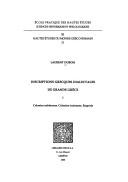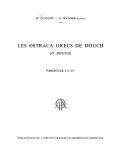| Listing 1 - 10 of 27 | << page >> |
Sort by
|

ISBN: 2600000410 9782600000413 Year: 1995 Volume: 19 Publisher: Genève: Droz,
Abstract | Keywords | Export | Availability | Bookmark
 Loading...
Loading...Choose an application
- Reference Manager
- EndNote
- RefWorks (Direct export to RefWorks)
Greek papyri --- Griekse papyri --- Handschriften [Griekse ] (Papyrus) --- Manuscripts [Greek ] (Papyri) --- Manuscrits grecs (Papyrus) --- Papyri [Greek ] --- Papyri [Griekse ] --- Papyrologie --- Papyrology --- Papyrus grecs --- Manuscripts, Greek --- Manuscripts, Greek (Papyri) --- Manuscrits grecs --- Catalogs --- Catalogues --- Egypt --- Egypte --- History --- Sources --- Histoire --- Greek language --- Texts. --- -Greek language --- -Manuscripts, Greek (Papyri) --- -Manuscripts, Greek --- -Greek manuscripts --- Greek philology --- Papyri, Greek --- Manuscripts, Classical (Papyri) --- Manuscripts (Papyri) --- Classical languages --- Indo-European languages --- Classical philology --- -Sources --- Texts --- -History --- Égypte --- Ägypten --- Egitto --- Egipet --- Egiptos --- Miṣr --- Southern Region (United Arab Republic) --- Egyptian Region (United Arab Republic) --- Iqlīm al-Janūbī (United Arab Republic) --- Egyptian Territory (United Arab Republic) --- Egipat --- Arab Republic of Egypt --- A.R.E. --- ARE (Arab Republic of Egypt) --- Jumhūrīyat Miṣr al-ʻArabīyah --- Mitsrayim --- Egipt --- Ijiptʻŭ --- Misri --- Ancient Egypt --- Gouvernement royal égyptien --- جمهورية مصر العربية --- مِصر --- مَصر --- Maṣr --- Khēmi --- エジプト --- Ejiputo --- Egypti --- Egypten --- מצרים --- United Arab Republic --- Sources. --- Manuscripts, Greek (Papyri) - France - Paris - Catalogs. --- Manuscripts, Greek (Papyri) - Egypt - Catalogs. --- Greek language - Texts.

ISBN: 2724703405 2724703413 2724703421 Year: 2003 Volume: 1. Publisher: Le Caire : Institut français d'archéologie orientale,
Abstract | Keywords | Export | Availability | Bookmark
 Loading...
Loading...Choose an application
- Reference Manager
- EndNote
- RefWorks (Direct export to RefWorks)
Romans --- Trade routes --- Fortification, Roman --- Eastern Desert (Egypt) --- Qusayr al-Qadim (Extinct city) --- Qif*t (Egypt) --- Egypt --- Oriental, Désert (Egypte) --- Qusayr al-Qadim (Ville ancienne) --- Egypte --- Antiquities, Roman. --- Antiquities. --- Antiquités romaines --- Antiquités --- Excavations (Archaeology) --- Rome --- Qusayr al-Qadīm (Extinct city) --- Army. --- Qusayr al-Qadīm (Extinct city). --- Qusayr al-Qadīm (Extinct city) --- Oriental, Désert (Egypte) --- Qusayr al-Qadīm (Ville ancienne) --- Antiquités romaines --- Antiquités
Book
ISBN: 2724703707 9782724707359 2724707354 9782724703702 Year: 2005 Volume: 2 51 Publisher: Le Caire: Institut français d'archéologie orientale,
Abstract | Keywords | Export | Availability | Bookmark
 Loading...
Loading...Choose an application
- Reference Manager
- EndNote
- RefWorks (Direct export to RefWorks)
La 4e de couverture indique : "Le fort de Krokodilô, fouillé en 1996 et 1997 par la Mission française du désert Oriental, est situé sur la route reliant Coptos, dans la Vallée du Nil, à Myos Hormos, sur la mer Rouge. Son dépotoir, formé sous les règnes de Trajan et Hadrien, a livré plus de 800 ostraca, dont 189 sont publiés dans ce volume. Après un premier volume des Ostraca de Krokodilô consacré à la correspondance militaire, le présent ouvrage s'intéresse à la correspondance privée que s'échangeaient les habitants de Krokodilô et des forts voisins, Phoinikôn et Persou. Les lettres ont été rédigées par trois personnalités très différentes : Philoklès, le vivandier et proxénète, joue un rôle central dans l'approvisionnement des habitants des fortins du désert, et dans le commerce de prostituées, dont il s'est fait une spécialité); Ischyras, le carrier, est une connaissance de Philoklès, ses lettres regorgent de manifestations d'amitié tout en livrant quelques confidences peu amènes, indices de rapports humains parfois brutaux ; Apollôs enfin, en plus d'être semble-t-il un soldat, assure le rôle de scribe au sein d'un groupe dont les préoccupations concernent presque uniquement le ravitaillement. La richesse de ce corpus permet de reconstituer la vie des petites sociétés peuplant les garnisons du désert au début du iie s. apr. J.-C., et de mettre en lumière la vigueur des réseaux qui liaient les quelque 200 personnages qui apparaissent dans les ostraca. On y découvre l'importance des liens de solidarité dans un milieu hostile et la place essentielle des civils, notamment des femmes, dans la vie des fortins." La 4e de couverture indique : "The fort of Krokodilo on the road from Coptos to Myos Hormos was excavated in 1996-97 by the French mission in the Eastern desert. Its rubbish-dump was formed during the reigns of Trajan and Hadrian, and produced over 800 ostraca, 189 of which are published in this volume. While the first volume of Ostraca de Krokodilô concerns military correspondence, this second volume contains private letters exchanged between the inhabitants of Krokodilo and the neighbouring forts, Phoinikon and Persou. The letters were written by three very different characters: Philokles, a green-grocer and pimp, plays a central role in supplying vegetables to the inhabitants of the desert forts and also organises the prostitution; Ischyras, a quarry-man, is an acquaintance of Philokles and his letters are full of declarations of friendship, but also contain some harsh remarks which demonstrate the brutality of certain human relationships; Apollos is probably a soldier, but also functions as a letter-writer for a group of people who are mostly concerned with their provisions of food. This rich corpus gives us a glimpse of the daily life in a society of some 200 people who lived in the desert garrisons at the beginning of the 2nd century AD, and who appear in the ostraca. We are able to witness the importance of solidarity in this hostile environment and the important role of civilians, not least the women, in the life around the forts."
Ostraca --- Inscriptions, Greek --- Military towns --- Inscriptions grecques --- Villes de garnison --- Translations into French --- History --- Sources --- Traductions françaises --- Histoire --- Rome --- History, Military --- Army --- Records and correspondence --- Histoire militaire --- Armée --- Documents et correspondance --- Ostraka --- Romans --- Arsinoé (Fayyûm, Egypt : Extinct city) --- Fayyûm (Egypt) --- Egypt --- Antiquities, Roman --- Arsinoë (Fayyūm, Egypt : Extinct city) --- Fayyūm (Egypt) --- Antiquities, Roman. --- Records and correspondence. --- Arsinoë (Fayyūm, Egypt : Extinct city). --- Traductions françaises --- Armée --- Ethnology --- Italic peoples --- Latini (Italic people) --- Potsherds (Ostraka) --- Paleography --- Pottery --- Writing materials and instruments --- Arsinoë (Fayyūm, Egypt : Extinct city) --- Fayyūm (Egypt) --- Rim --- Roman Empire --- Roman Republic (510-30 B.C.) --- Romi (Empire) --- Byzantine Empire --- Rome (Italy) --- Fayum (Egypt) --- Fayoum (Egypt) --- Faiyum (Egypt) --- Fayyoum (Egypt) --- Fayoom (Egypt) --- Madīnet el Faiyūm (Egypt) --- Medinat Fayum (Egypt) --- Médinate el-Fayoum (Egypt) --- Madīnat al-Fayyūm (Egypt) --- Égypte --- Ägypten --- Egitto --- Egipet --- Egiptos --- Miṣr --- Southern Region (United Arab Republic) --- Egyptian Region (United Arab Republic) --- Iqlīm al-Janūbī (United Arab Republic) --- Egyptian Territory (United Arab Republic) --- Egipat --- Arab Republic of Egypt --- A.R.E. --- ARE (Arab Republic of Egypt) --- Jumhūrīyat Miṣr al-ʻArabīyah --- Mitsrayim --- Egipt --- Ijiptʻŭ --- Misri --- Ancient Egypt --- Gouvernement royal égyptien --- جمهورية مصر العربية --- مِصر --- مَصر --- Maṣr --- Khēmi --- エジプト --- Ejiputo --- Egypti --- Egypten --- מצרים --- United Arab Republic --- Arsinoiton polis (Fayyūm, Egypt : Extinct city) --- Crocodilopolis (Fayyūm, Egypt : Extinct city) --- Krokodilon polis (Fayyūm, Egypt : Extinct city) --- Krokodilopolis (Fayyūm, Egypt : Extinct city) --- Ptolemais Euergetis (Extinct city) --- Setje (Extinct city) --- Shedet (Extinct city) --- Antiquities --- Garnisons --- Fouilles archéologiques --- Correspondance --- Égypte --- Sources. --- Excavations (Archaeology) --- Social networks --- History. --- Social life and customs --- Ostraka - Egypt - Arsinoé (Fayyûm : Extinct city) --- Romans - Egypt - Arsinoé (Fayyûm : Extinct city) --- Fayyûm (Egypt) - Antiquities, Roman --- Rome - Army - Records and correspondence --- Egypt - History - 30 B.C.-640 A.D. - Sources
Book
Year: 1985 Publisher: Bruxelles: Fondation égyptologique Reine Élisabeth,
Abstract | Keywords | Export | Availability | Bookmark
 Loading...
Loading...Choose an application
- Reference Manager
- EndNote
- RefWorks (Direct export to RefWorks)
Book
Year: 1985 Publisher: Bruxelles : Fondation égyptologique reine Elisabeth,
Abstract | Keywords | Export | Availability | Bookmark
 Loading...
Loading...Choose an application
- Reference Manager
- EndNote
- RefWorks (Direct export to RefWorks)
Arpentage --- Land tenure --- Land use --- Landesaufnahme. --- Manuscripts, Greek (Papyri) --- Papyrus grecs. --- Ägypten (Altertum).
Book
Year: 2010 Publisher: München Beck
Abstract | Keywords | Export | Availability | Bookmark
 Loading...
Loading...Choose an application
- Reference Manager
- EndNote
- RefWorks (Direct export to RefWorks)
Book
Year: 1985 Publisher: Bruxelles Fondation égyptologique Reine Elisabeth
Abstract | Keywords | Export | Availability | Bookmark
 Loading...
Loading...Choose an application
- Reference Manager
- EndNote
- RefWorks (Direct export to RefWorks)
Book
Year: 1985
Abstract | Keywords | Export | Availability | Bookmark
 Loading...
Loading...Choose an application
- Reference Manager
- EndNote
- RefWorks (Direct export to RefWorks)

ISBN: 272470035X 2724700368 2724702433 2724703073 2724700570 2724701186 9782724700350 Year: 1988 Volume: 24/2 Publisher: Le Caire: Institut français d'archéologie orientale,
Abstract | Keywords | Export | Availability | Bookmark
 Loading...
Loading...Choose an application
- Reference Manager
- EndNote
- RefWorks (Direct export to RefWorks)
Ostraka. --- Inscriptions, Greek --- Ostraka --- Ostraca --- Kysis (Extinct city) --- Kysis (Ville ancienne) --- -Ostraka --- Potsherds (Ostraka) --- -Cysis (Extinct city) --- Dūsh, Tall (Egypt) --- Kysis (Ancient city) --- Qasr Dush (Egypt) --- Tall Dūsh (Egypt) --- Paleography --- Pottery --- Writing materials and instruments --- Greek inscriptions --- Greek language --- Greek philology --- Cysis (Extinct city) --- Egypt --- History --- Sources. --- Antiquities --- Inscriptions grecques --- Sources --- Histoire --- Inscriptions, Greek - Egypt - Kysis (Extinct city) --- Khargeh (Égypte) --- Fouilles archéologiques --- Égypte --- Douch (Égypte ; site archéologique) --- Temple de Douch --- Kysis (ville ancienne)
Book
ISBN: 9781479810741 1479810746 147981069X Year: 2021 Publisher: New York
Abstract | Keywords | Export | Availability | Bookmark
 Loading...
Loading...Choose an application
- Reference Manager
- EndNote
- RefWorks (Direct export to RefWorks)
A detailed archaeological study of life in Egypt's Eastern desert during the Roman period by a leading scholarRome in Egypt’s Eastern Desert is a two-volume set collecting Hélène Cuvigny’s most important articles on Egypt’s Eastern desert during the Roman period. The fort excavations that she has directed have uncovered a wealth of material, including tens of thousands of texts written on pottery fragments (ostraca). Some of these are administrative texts, but many more are correspondence, both official and private, written by and to the people (mostly but not all men) who lived and worked in these remote and harsh environments, supported by an elaborate network of defense, administration and supply that tied the entire region together. The contents of Rome in Egypt’s Eastern Desert have all been published earlier in peer-reviewed venues, but almost entirely in French. All of the contributions have been translated by the editor and brought up to date with respect to bibliography and in some cases significantly rewritten by the author, in order to take account of the enormous amount of new material discovered in the intervening time and subsequent publications. A full index makes this body of work far more accessible than it was before. This book brings together thirty years of detailed study of this material, bringing to life the geography, administration, military, quarry operations, life in the forts, and the religion and expressive language of the population who lived in them.
Excavations (Archaeology) --- Romans --- Fortification, Roman
| Listing 1 - 10 of 27 | << page >> |
Sort by
|

 Search
Search Feedback
Feedback About UniCat
About UniCat  Help
Help News
News